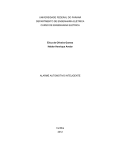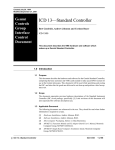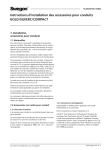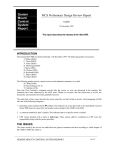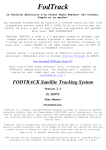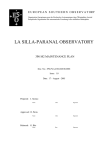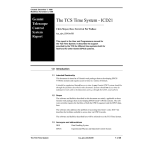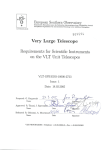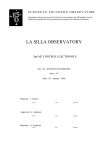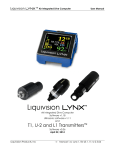Download LSO-MMN-ESO-60400-00..
Transcript
E U R O P E A N S O U T H E R N O B S E R V A T ORY Organisation Européenne pour des Recherches Astronomiques dans l'Hémisphère Austral Europäische Organisation für astronomische Forschung in der südlichen Hemisphäre LA SILLA OBSERVATORY TIME MACHINE INSTALLATION AND USER’S MANUAL Doc. No.: LSO-MMN-ESO-60100-0001 Issue: 2.0 Date: 8-January-2005 Prepared: J. Alonso Name Date Signature Date Signature Approved: G. Andreoni Name Released: G. Andreoni Name Date Signature Page 2 TIME MACHINE INSTALLATION AND USER’S MANUAL 8-Jan- 2005 Doc. LSO-MAN-ESO-60100-0001 Technical Document CHANGE RECORD Revision Date Section/Paragraph Remarks Issue 1.0 Issue 2.0 14/12/2002 08/01/2005 All Several First Issue Page 3 TIME MACHINE INSTALLATION AND USER’S MANUAL 8-Jan- 2005 Doc. LSO-MAN-ESO-60100-0001 Technical Document INDEX OF CONTENTS 1. INTRODUCTION .............................................................................................................................4 1.1. 1.2. 1.3. 1.4. 2. TIME MACHINE OVERVIEW..................................................................................................4 REFERENCE DOCUMENTS.....................................................................................................5 APPLICABLE DOCUMENTS ...................................................................................................6 ACRONYMS & ABBREVIATIONS..........................................................................................6 HARDWARE SETUP .......................................................................................................................7 2.1. TM PHYSICAL PLACEMENT ..........................................................................................................7 2.2. TM POWER REQUIREMENTS .........................................................................................................7 2.3. TM ELECTRICAL AND OPTICAL CONNECTIONS ............................................................................7 2.3.1. Front Panel..........................................................................................................................7 2.3.2. Rear Panel ...........................................................................................................................8 3. SOFTWARE SETUP AND COMMANDS .....................................................................................9 3.1. BOOT PARAMETERS......................................................................................................................9 3.2. COMMANDS ................................................................................................................................10 3.2.1. Stand_alone_mode............................................................................................................10 3.2.2. GPS_mode.........................................................................................................................10 3.2.3. Set_time.............................................................................................................................10 3.2.4. Set_julian_day ..................................................................................................................11 3.2.5. Time_offset........................................................................................................................11 4. OPERATION...................................................................................................................................11 4.1. 4.2. 4.3. 4.4. 4.5. 5. COLD START...............................................................................................................................11 GPS MODE..................................................................................................................................12 STAND ALONE MODE ..................................................................................................................12 PRECAUTIONS .............................................................................................................................12 REBOOT ......................................................................................................................................13 APPENDIX ......................................................................................................................................13 5.1. 5.2. 5.3. 5.4. 5.5. LA SILLA TELESCOPES TIME REQUIREMENTS .............................................................................13 TM OCXO STABILITY ...............................................................................................................14 TM OCXO DISCIPLINED RUN ....................................................................................................14 TM OCXO OPEN LOOP RUN ......................................................................................................15 OCXO CONTROL VOLTAGE REFERENCE VALUE........................................................................15 INDEX OF FIGURES FIGURE 1: TM BLOCK DIAGRAM ..................................................................................................................5 FIGURE 2: TM FRONT PANEL .......................................................................................................................8 FIGURE 3: TM REAR PANEL .........................................................................................................................9 FIGURE 4: TIME REQUIREMENTS TABLE .....................................................................................................13 FIGURE 5: OCXO 18 HRS RUN, OPTIMISED CONTROL PARAMETERS (DEPARTURE FROM THE GPS 1PPS) ...14 FIGURE 6: OCXO 16 HOURS OPEN LOOP RUN (DEPARTURE FROM THE GPS 1PPS).....................................15 Page 4 TIME MACHINE INSTALLATION AND USER’S MANUAL Technical Document 1. 8-Jan- 2005 Doc. LSO-MAN-ESO-60100-0001 INTRODUCTION 1.1. TIME MACHINE OVERVIEW The Time Machine (TM) is a clock capable of generating a Time Interface Module (TIM) signal. The TM has two modes of operation, “GPS” and “Stand alone”, this makes it very versatile and safe. In “GPS” mode the TM is always disciplining it’s quartz Oven Controlled Crystal Oscillator (OCXO) and storing the average control voltage value every 24 hours in it’s battery backed up Complementary Metal Oxide Semiconductor (CMOS) Random Access Memory (RAM). In “Stand alone” mode the OCXO is operated using the latest averaged value found in the CMOS RAM. The core of the TM is built in a Versa Module Europe (VME) module, which operates controlled by a MVME167 Central Processing Unit (CPU) running the necessary control and interface software. All the system is housed in a VME crate, which additionally contains an OCXO unit and a Global Positioning System (GPS) receiver. Please refer to Figure 1 below for a better visualization. Basically the TM VME module interacts with three different sub-systems via VME bus independent lines and with the CPU via the VME bus itself. The TM VME module interacts with the OCXO from where it receives a 10Mhz signal and phase compares it with the GPS or external 1 Pulse Per Second (PPS), the resultant error signal is filtered by a digital Proportional Integral (PI) controller with an adjustable time constant of several hours and the output is fed to a 20 bit Digital to Analogue (D/A) converter to obtain the OCXO control voltage. While the GPS_OK signal is asserted the OCXO control loop remains closed and the control voltage updated once every 10 seconds, if the GPS_OK signal fail the control voltage is frozen with an average value. The phase measuring and control voltage resolutions are 25nS and 10uV respectively. The TM VME module interacts with the EconoGPS from where it receives three different signals, a serial string containing the Universal Time Coordinated (UTC) hours, minutes, seconds and modified Julian day, a 1 Pulse Per Second (PPS) reference signal and the GPS_OK flag. The UTC information string is manipulated by the software in the CPU and loaded into the serializing Electrically Programmable Logic Device (EPLD) using interrupts for synchronisation. Since the TIM signal is a serial 1 Mhz carrier that contains all the UTC information in Pulse Width Modulation (PWM) encoded format, it is necessary a dedicated hardware for this function. Inside the EPLD a group of counters, latches, flip-flops, shift registers and gates are responsible for this time critical task. This EPLD is seen by the microprocessor as a standard peripheral circuit very much like a standard Universal Synchronous Asynchronous Receiver Transmitter (USART) normally used for standard RS-232 interfaces. The TM VME module interacts with the Time Bus Distribution Box (TBDB-TX) ESO standard module. This is a simple converter from balanced differential to four ST optical outputs. For further details please refer to [RE5]. Page 5 TIME MACHINE INSTALLATION AND USER’S MANUAL 8-Jan- 2005 Doc. LSO-MAN-ESO-60100-0001 Technical Document The TM VME module interacts with the VME bus for communication with the MVME167 CPU. TIME MACHINE VME CRATE TB1 TIM SIGNAL TBDB-TX TB2 TB3 TB4 MVME167 CPU RS-232 TM VME MODULE LAN OPTICAL TIM SIGNAL OUTPUTS EXTERNAL 1 PPS 1 PPS GPS_OK EconoGPS SERIAL DATA ANTENNA CONTROL VOLTAGE OCXO 10 Mhz VME bus Figure 1: TM Block Diagram Although the system exploits a GPS both for disciplining the built in high stability quartz OCXO and obtaining the UTC and modified Julian date, the GPS can be dropped at any time and operated as a high quality stand alone quartz clock keeping the latest average control voltage for the OCXO. As a GPS independent system it is possible, when required, to discipline the oscillator using any high quality1 PPS source such as a Rubidium or Cesium oscillator to correct for the long-term drift and aging of the quartz, as well as manually set the UTC, modified Julian day and increase or decrease the time by +/-999 mS in steps of 1mS. 1.2. REFERENCE DOCUMENTS [RE1] La Silla time distribution system requirements. M. Mornhinweg. [RE2] Time Reference System of the ESO Very Large Telescope Werner R. Lange, Martin Ravensbergen. [RE3] Time Reference System of the VLT Martin Ravensbergen, Krister Wirestrand. [RE4] GARMIN GPS 25 LP Series Technical Specification [RE5] VLT Time Reference System TBDB Test Report F. Biancat VLT-TREESO-17300-0848. Page 6 TIME MACHINE INSTALLATION AND USER’S MANUAL Technical Document 1.3. 8-Jan- 2005 Doc. LSO-MAN-ESO-60100-0001 APPLICABLE DOCUMENTS [AP1] Time Reference System, Time Interface Module, Technical Manual M. Ravensbergen. VLT-MAN-ESO-17300-473 [AP2] VLT Time Reference System Datum Unit Test Report F. Biancat VLTTRE-ESO-17300-0849. [AP3] La Silla EconoGPS Clock Preliminary Technical Documentation Version 2.0 M. Mornhinweg. [AP4] Procedure for Calibration of Time Sources LSO-PRO-ESO-60500-0002. 1.4. GPS CMOS RAM TIM TM VME OCXO TBDB TBD VLT NTT EPLD PPS D/A USART CPU PWM UTC UPS ACRONYMS & ABBREVIATIONS Global Positioning System Complementary Metal Oxide Semiconductor Random Access Memory Time Interface Module Time Machine Versa Module Europe Oven Controlled Crystal Oscillator Time Bus Distribution Box To Be Defined Very Large Telescope New Technology Telescope Electrically Programmable Logic Device Pulse Per Second Digital to Analogue Converter Universal Synchronous Asynchronous Receiver Transmitter Central Processing Unit Pulse Width Modulation Universal Time Coordinated Uninterruptible Power Source Page 7 TIME MACHINE INSTALLATION AND USER’S MANUAL Technical Document 2. 8-Jan- 2005 Doc. LSO-MAN-ESO-60100-0001 HARDWARE SETUP 2.1. TM Physical Placement Since the TM contains a sensitive OCXO it shall, at least, be placed in a solid table free of vibrations, and a fairly constant ambient temperature must be assured. Recently at the 3.6m telescope a shielded ventilated metallic enclosure/support was mounted fixed to the wall of the telescope control system’s room. Inside this enclosure the TM’s VME chassis is now housed. 2.2. TM Power Requirements An Uninterruptible Power Source (UPS) shall be used for powering the TM. Since the system contains an OCXO it must be powered continuously to ensure constant temperature and thus constant frequency and stable and reliable TIM output signal. The operating voltage is 230VAC and the maximum power consumption is 200W. The warm up period is at least 2.5 hours. The power switch does not turn off the OCXO therefore as soon as the TM power cord is plugged to the mains the warm up period of the OCXO starts. 2.3. TM Electrical and Optical Connections 2.3.1. Front Panel At the front panel of the TM the following connectors are available (please refer to Figure 2 for additional details): ¾ Four optical TIM signal outputs. These signals can be distributed to TIM modules as well as time displays, a multimode ST type connector terminated optical fibre shall be used. ¾ One GPS antenna connector. To access this connector the EconoGPS module shall be unscrewed and pulled half way out. Behind the rubber grommet you will see the press-fit miniature connector mounted onto the GPS core. ¾ The EconoGPS serial data link. Via this cable the EconoGPS sends to the TM VME module (when in GPS mode) the hours, minutes, seconds and modified Julian day. ¾ Seven balanced differential signal outputs are available. The frequencies are: 1Mhz, 100Khz, 10Khz, 1Khz, 100Hz, 10Hz and 1Hz (connector type LEMO #0 2 pins). ¾ One balanced differential GPS 1 PPS output is located below the D-sub connector of the data link (connector type LEMO #0 2 pins) ¾ At the left side of the data link D-sub connector there are located three miniature banana plug receptacles red, white and black. The black is the circuit ground, the white and the red are, 156250 Hz output and the GPS 1 PPS output respectively. These signals are single ended and are used for test purposes. Page 8 TIME MACHINE INSTALLATION AND USER’S MANUAL 8-Jan- 2005 Doc. LSO-MAN-ESO-60100-0001 Technical Document Figure 2: TM Front Panel 2.3.2. Rear Panel At the rear panel of the TM the following connectors are available (please refer to Figure 3 for additional details) ¾ One ASCII terminal RS-232 connection for both sending commands and monitoring purposes. Any ANSI terminal or terminal emulator on a PC set to 9600 baud, 8 bits, no parity and 1 stop bit should work. ¾ One standard UTP network connection for downloading both the operating system and the TM program. ¾ Terminals for monitoring the OCXO control voltage using a DC voltmeter. The voltage range is 0 to 10V. ¾ The mains 220V plug. Page 9 TIME MACHINE INSTALLATION AND USER’S MANUAL 8-Jan- 2005 Doc. LSO-MAN-ESO-60100-0001 Technical Document Figure 3: TM Rear Panel 3. SOFTWARE SETUP AND COMMANDS 3.1. Boot Parameters The IP address “inet on ethernet” corresponds to the address assigned by the system administrator for the operation of the TM at the 3.6m telescope. boot device processor number host name file name inet on ethernet (e) host inet (h) gateway inet user (u) ftp password (pw) flags (f) target name (tn) startup script (s) : ei :0 : kila : /home1/elteam3/vw/config/mv167/vxWorks : 134.171.121.196 : 134.171.81.13 : 134.171.121.21 : elteam3 : abc123 : 0x8 : vxclk2 : /home1/elteam3/lsotrs/ss Page 10 TIME MACHINE INSTALLATION AND USER’S MANUAL Technical Document 3.2. 8-Jan- 2005 Doc. LSO-MAN-ESO-60100-0001 Commands 3.2.1. Stand_alone_mode NAME Stand_alone_mode() SYNOPSIS STATUS Stand_alone_mode(void) DESCRIPTION This function switches the TM to GPS independent mode. In this mode the time and the Julian day must be manually set and the OCXO disciplining is frozen. The OCXO voltage is set using the last average stored in the CMOS RAM. The command can be issued at any time. 3.2.2. GPS_mode NAME GPS_mode() SYNOPSIS STATUS GPS_mode(void) DESCRIPTION This function switches the TM to GPS dependent mode. In this mode the time and the Julian day is read into the TM via the serial link from the EconoGPS. In this mode the OCXO disciplining is active if the GPS_OK signal is asserted. When the GPS_OK signal fails the OCXO disciplining is momentarily frozen. The command can be issued at any time. 3.2.3. Set_time NAME Set_time() SYNOPSIS STATUS Set_time(hours,minutes,seconds) Unsigned char hours; Unsigned char minutes; Unsigned char seconds; Page 11 TIME MACHINE INSTALLATION AND USER’S MANUAL Technical Document 8-Jan- 2005 Doc. LSO-MAN-ESO-60100-0001 DESCRIPTION This function sets the time of the TM when operating in stand-alone mode. The command can be issued only in stand-alone mode and the format is 24 hours. 3.2.4. Set_julian_day NAME Set_julian_day() SYNOPSIS STATUS Set_julian_day(day) int day; DESCRIPTION This function sets the Modified Julian day of the TM when operating in standalone mode. The command can be issued only in stand-alone mode and the numeric range is 0 to 99999 days. 3.2.5. Time_offset NAME Time_offset() SYNOPSIS STATUS Time_offset(offset) int offset; DESCRIPTION This function introduces a +/- time offset when the TM operates in stand-alone mode. The command can be issued only in stand-alone mode and the numeric range is 999 to 999 milliseconds. 4. OPERATION 4.1. Cold Start After setting up the ANSI terminal and connecting the network the mains should be connected. At this point it is recommended to leave the GPS antenna disconnected. Switch on the power at the front panel just to check if the system is booting properly. Wait 2.5 hours for the OCXO to stabilize, if you prefer the power switch can be turned (of course leaving the mains plugged) off during this period. If you leave the system on you will notice that the time and status display will start counting from 0 and the message “STAND ALONE MODE” will be displayed. Now you can connect the GPS antenna and after some minutes the GPSOK led in the TM’s front panel will lit but the mode will remain stand-alone. Page 12 TIME MACHINE INSTALLATION AND USER’S MANUAL Technical Document 8-Jan- 2005 Doc. LSO-MAN-ESO-60100-0001 After 2.5 hours you can reboot the system just by pressing the reset button, if the GPSOK signal is present at boot time the system will automatically enter the GPS mode after boot and the message “GPS MODE sigOK” will be displayed. If you issue the command “GPS_mode” the system will be forced to GPS mode. At this point if the GPS signal is available the message “GPS MODE sigOK” will be displayed if not the message “GPS MODE sigLOST” will be displayed. Note that only at boot time if the GPSOK signal is asserted the system enters the GPS mode and if not remains in stand-alone mode. After booting the only way to change mode is by issuing the respective commands. 4.2. GPS mode In this mode the TM reads the hours, minutes, seconds and modified Julian day from the EconoGPS via the serial link and it uses the 1 PPS GPS signal for disciplining the OCXO. It also continuously monitors the GPSOK signal for momentarily stopping the disciplining, in case of signal failure, avoiding upsetting the OCXO control. During these faulty periods the message “GPS MODE sigLOST“ is displayed. Every 24 hours a new number resulting from the averaged control voltage values of the OCXO is stored in a battery backed up CMOS RAM for use in case of GPS signal loss or in stand-alone mode. 4.3. Stand alone mode In this mode the TM keeps internally the hours, minutes, seconds and modified Julian day. There is no OCXO disciplining and the control voltage is set using the last average stored in the CMOS RAM. After entering this mode the time and Julian day must be manually set using the “Set_time” and “Set_julian_day” commands. The time can be fine tuned with the aid of the “Time_offset” command. 4.4. Precautions In the advent of a thunderstorm it would be highly desirable to disconnect the GPS antenna from the TM. If you go outside the catwalk by the small corridor next to the TM you will see it in front of you. The antenna is magnetically fixated to a support mounted over the catwalk fence. Just before going out you will see at your left a plastic tray with the antenna’s coax, in the upper section of the tray there is a BNC type coupling that can be unplugged for disconnecting. Page 13 TIME MACHINE INSTALLATION AND USER’S MANUAL 8-Jan- 2005 Doc. LSO-MAN-ESO-60100-0001 Technical Document 4.5. Reboot At the front panel of the MVME167 CPU press the button labelled “reset”, in a couple of minutes the TM will automatically restart. Please be aware that if the “GPSOK” yellow LED is off after reboot it is necessary to input by hand both the UTC and the Modified Julian Day. After manual input it is necessary to trim the UTC following the procedure described on [AP4]. 5. Appendix 5.1. La Silla Telescopes Time Requirements Telescope Format UTC Format ST Absolute Precision 100 day NTT & 3.6 2.2 1.54 1.52 1m & Dutch TIM bus Visual Visual display Visual Visual None Visual + BCD BCD BCD Visual + 1Khz 0.5s 0.5s 1s 1s 1s 0.05s 0.5s 1s 1s 1s Figure 4: Time Requirements Table For further details on La Silla telescopes time requirements please refer to [RE1]. Page 14 TIME MACHINE INSTALLATION AND USER’S MANUAL 8-Jan- 2005 Doc. LSO-MAN-ESO-60100-0001 Technical Document 5.2. TM OCXO Stability The TM system uses an Oscilloquartz model B-5400 OCXO with a specified aging rate of <10E-10 per day after 90 days of continuous operation and a short-term stability of 10E-12 in 10 seconds. We have no long-term stability specification. The OCXO has been running continuously for more than a year. The tuning range is 1.5X10E-7 with an external voltage range of +1 to +10V. The output frequency is 10Mhz. 5.3. TM OCXO Disciplined Run Phase KP=12 KI=140 T=36000 15-12-02 250 200 150 Nanoseconds 100 50 0 -50 0 200 400 600 800 1000 1200 -100 -150 -200 -250 Minutes Figure 5: OCXO 18 hrs run, optimised control parameters (departure from the GPS 1PPS) Page 15 TIME MACHINE INSTALLATION AND USER’S MANUAL 8-Jan- 2005 Doc. LSO-MAN-ESO-60100-0001 Technical Document 5.4. TM OCXO Open Loop Run PHASE Open loop VCXO = -34072 23-10-02 800 600 Nano Seconds 400 200 0 0 100 200 300 400 500 600 700 800 900 1000 -200 -400 -600 Minutes Figure 6: OCXO 16 hours open loop run (departure from the GPS 1PPS) 5.5. OCXO Control Voltage Reference Value After the first a 10 days disciplined run of the OCXO the computed value was 27367 corresponding to +5.2611 volts. Being this value a good starting point in case of problems with the CMOS RAM back-up battery we mention it here. The value can be entered by hand by issuing the command “write_ram 27367”, and checked by issuing the command “read_ram”. Optionally a DC voltmeter can be connected to the OCXO monitoring terminals at the rear panel Figure 2. By issuing the “Stand_alone_mode” command you should be able to measure +5.2611 volts at the terminals.















